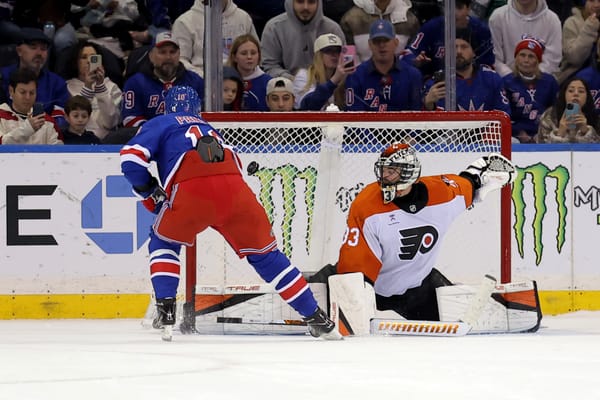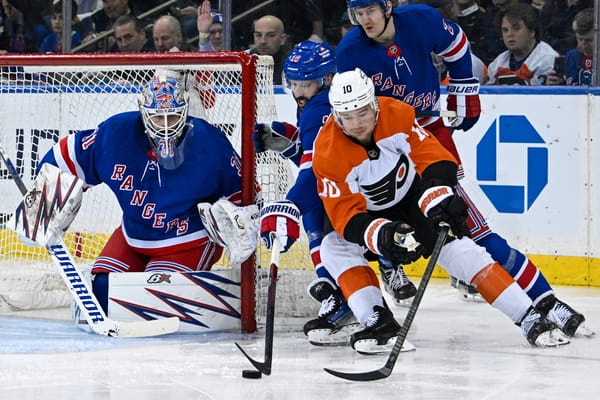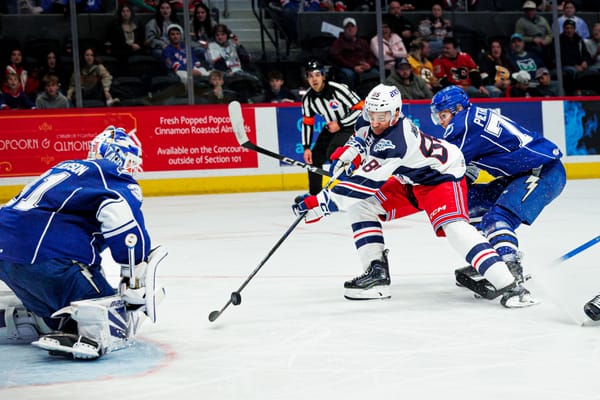2022 Report Card: Braden Schneider
After arriving in the NHL sooner than most prognosticators expected, Schneider established himself as an everyday player by the time the dust settled on his rookie season
When the Rangers used the 19th pick of the 2020 Entry Draft on Braden Schneider, the selection raised a few eyebrows. Adam Fox was coming off a strong rookie season that saw him earn down ballot consideration for the Calder Trophy and make the All-Rookie team. Jacob Trouba had just finished the first of a seven year deal and whether it be because of his play or his pay, was locked into a top four spot on the right side blue line for the foreseeable future. Nils Lundkvist was one of the most highly regarded defensive prospects in the NHL and was arguably the top prospect in New York’s system at the time.
Schneider spent the majority of his first post-draft season in WHL Brandon before making the leap to the pros for the 2021-22 campaign. Although he failed to make the opening night roster, Schneider went to AHL Hartford and plugged away until being recalled on January 11th. From there, Schneider played in 43 of the remaining 45 regular season games and drew into the lineup for each of New York’s 20 playoff contests en route to the Eastern Conference Finals. So how did he do in those games?
Boxcar Stats: 43 GP, 2 G, 9 A, 25 SOG, 15:28 TOI/GP, 9 PIM, -2 Penalty Differential, +3 On-Ice Goal Differential
5-on-5 Analytical Metrics: 0.95 Points/60, -8.93 Relative CF%, -8.80 Relative SF%, -1.60 Relative GF%, -7.52 Relative Expected GF%, -7.56 Relative SCF%, 103.4 On-Ice PDO, 1.0 GAR
Playoff Stats: 0 Goals, 3 Assists, 11:08 TOI/GP, -3.89 Relative CF%, -3.31 Relative xGF%, -3 On-Ice Goal Differential
Although Nils Lundkvist beat him out for a roster spot to open the season, Lundkvist was the one sent down to Hartford when Schneider was called up, and it was Schneider who became a mainstay in New York’s lineup down the stretch. Schneider made his NHL debut on January 13th against the San Jose Sharks, and the rookie wasted little time making his mark by scoring a goal in his first game:
Schneider spent the majority of the regular season partnered with Patrik Nemeth, with nearly 59% of his 5-on-5 minutes occurring alongside the now-former Ranger. When Nemeth was out of the lineup, Schneider usually found himself skating alongside Ryan Lindgren, Zac Jones, or Justin Braun, each of whom partnered with Schneider for roughly 11% of Schneider’s minutes. Nemeth opened the playoffs skating alongside Schneider on the third pair, but Gerard Gallant had seen enough after four games against Pittsburgh, and Braun took over for Nemeth for the final 16 playoff games.
When evaluating Schneider’s play there’s a lot of context, to examine. On one hand, most Rangers fans would say they thought he played well after being recalled and proved his mettle by becoming an everyday player for a Conference finalist as a 20 year old. On the other hand, the shot and scoring chance differentials tell the story of a player who was a major drag on the team every time he hopped over the boards, and parsing through why that is and whether Schneider is to blame for that becomes the question at hand.
As previously stated, Schneider played more time with Nemeth than all other defenders combined. After rumors of a buyout swirled but never came to pass, the Rangers attached a pair of draft picks to Nemeth in order for the Coyotes to take on the final two seasons of his contract. Nemeth was New York’s worst defenseman in every metric across the board, so it’s fair to say Schneider’s poor on-ice results lay somewhat with his partner.
However, Nemeth’s numbers with Schneider were significantly worse compared to his second most common defensive partner, that being Nils Lundkvist. Both the Nemeth-Schneider pairing (+14/15) and Nemeth-Lundkvist pairing (+7/-8) were minus one in goal differential, but the relative shot and chance numbers strongly favor the Nemeth-Lundkvist pairing.
Using the 238 minutes Nemeth and Lundkvist played together as the cutoff, 142 defensive pairs qualify for these rankings. The Nemeth-Lundkvist pairing didn’t fare too well, as they ranked 126th in shot attempts, 134th in scoring chances, 127th in shots on goal, and 108th in expected goals. In spite of their struggles, they still outperformed the Nemeth-Schneider pairing, as their time together saw them place 141st in shot attempts, 138th in scoring chances, 142nd in shots on goal, and 142nd in expected goals.
Lundkvist wasn’t outstanding during his NHL stint, but the narrative surrounding him and Schneider doesn’t quite line up with their play. Nothing here points to Schneider firmly establishing himself as an NHL caliber player quite yet. There’s something to be said about making the NHL at age 20, but the kudos from that only go so far when that 20 year old didn’t play particularly well by any metric of your choosing.
When the playoffs rolled around. Schneider usually found himself watching the latter stages of close games from the bench as Gerard Gallant shortened his bench. That’s not a matter of a coach just trusting his young defenseman, as no Ranger had more ice time than second year pro K’Andre Miller. Aside from getting his pocket picked by 37 year old Brian Boyle to lead directly to a goal against in Game 3 of the first round, Schneider played nondescript hockey for the Blueshirts. That was reflected in finding himself under the ten minute mark in time on ice for half of the team’s playoff games, including four of the final six contests against Tampa Bay.
Final Thoughts:
Schneider becoming an everyday player in 2021-22 wasn’t something most Rangers fans expected to happen. After only 26 AHL games, Schneider appears to have made the permanent leap to Broadway and should be a big part of this next window of contention the team opened this season. The on-ice results were anything but pretty for Schneider, but there’s some leeway to be given due to immense struggles from his primary defensive partner.
Schneider is currently slated to be paired with one of the organization’s young, left handed defenders. Matthew Robertson and Zac Jones are the top two names on that list, although Libor Hajek is still hanging around the depth chart and could serve as a fallback option on the third pair. Whoever Schneider ends up playing alongside, his play next season will answer some of the questions residents of Rangerstown were left with when his rookie season concluded.
Author Grade: C-
Masthead Average: C+ (1 B-, 3 C+’s, 2 C’s, 1 C-)
*All Data via Natural Stat Trick and Evolving Hockey





